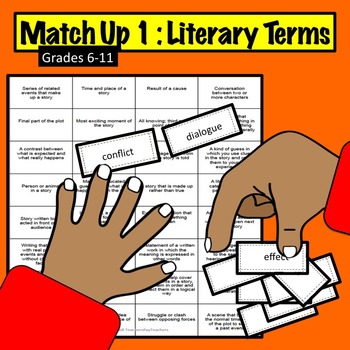Match Up #1 : Literary Terms Game
- Zip
Also included in
- Lessons, PowerPoints, Worksheets, and MORE are all bundled for easy, no-prep teaching for months.This Mega Store Bundle is the final chunk to Buy My Store. Save OVER 50% when you buy a Mega Store Bundle rather than purchasing products separately.Please check individual products for detailed descriptPrice $74.20Original Price $146.25Save $72.05
- Four PowerPoints with 180 Task Cards feature 180 challenging vocabulary words that are on-level with the S.A.T. (examples include: Ubiquitous, Pristine and Acquiesce). This bundle includes Sets 1, 2, 3 and 4 that are sold separately. Click on S.A.T. Word of the Day PPT and Task Cards Set 1 to checkPrice $9.75Original Price $17.25Save $7.50
- All Seven of my Match- Up activities are available here for one low price. In addition, an editable Match-Up is included.Click on the link to read the description (and reviews!) of each product: Match-Up #1 Literary TermsMatch-Up #2 Poetry TermsMatch-Up #3 Poetry StructureMatch Up #4 Roots... PLUS:Price $12.50Original Price $17.00Save $4.50
Description
This Literary Terms Match-Up Game is effective, fun, and can be used over and over in the classroom! PERFECT for Centers!
Accompanied with an EATS lesson plan and following the Common Core RI.7.4., the placemat "board" gives 28 definitions.
Literary terms included are: Dialogue, Figurative language, Plot Inference, Genre, Suspense, Imagery, Theme, Flashback, Irony,
Effect, Omniscient, Point of View, Fiction, Cause, Paraphrase, Retelling, Conflict, Setting, Climax, Foreshadowing, Predict, Stanza, Tone, Mood, Main idea, Resolution,Character, Drama, Non-fiction, Narration, Onomatopoeia. The answer key is provided not only to make life easier, but to allow students to check their own work.
At the beginning of the year, have students work in groups to match the term to the definition. As the year progresses, use it as a review to see if the students learned the material. Eventually, students will complete the activity individually.
It is a great activity for the end of the year, too. You will be impressed how much the students have learned. What took them 20 minutes at the beginning of the year now takes 5 minutes for many students!
Throughout the year, I use this as a "filler" when the power goes out or a bomb threat is called in (Yes, it happens!) without wasting students' time.
Once, my principal unexpectedly visited my classroom while the students were working on this activity- and he asked if I made this myself. He was impressed. Yay! (The happiness we teachers get from a pat on the back...)
I suggest making copies of the game pieces with colored paper so the words stand out more. (Mine was printed on colored paper- in the picture. Laminating the game board and pieces (hint: BEFORE you cut them apart) is a really good idea as well!
I also print out copies and give at Open House or at conferences. My students' parents were very grateful!
Great for individual work, centers, cooperative learning, these Match Up Activities are so convenient to have on hand throughout the year. Students match up literary terms (or poetry structure… or root words…) to the game board. Match Up Activities are perfect sponge activities, too! Check out the feedback.
My Match Up Activity Game # 1 was so popular, I've made many more. Here are some to check out:
Several Copies of Match Up:
4 Roots
5 Roots
8 Women Leaders (Coming Soon!)
9 Match Up Bundle ---Get All for one Price!
I hope you enjoy!
Thanks!
~Kim Kroll






